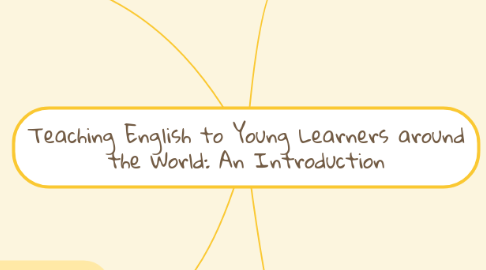
1. Common features of Effective EYL programs
1.1. Focused on meaning
1.2. Use task-based and content-based approaches
1.3. Provided fun in classroom
1.4. Set up children for success
1.5. Set realistic expections and assessment
2. Reasons for an Early Start
2.1. The Value of English for Education and Employment
2.1.1. Countries have adopted English as part of their education.
2.1.2. English is used for business and communication.
2.1.3. English is a "Lingua franca", people with a different language can use it to communicate each other.
2.2. The benefits of Early Language Learning
2.2.1. The value of increase time
2.2.1.1. YLs have more time to learn the language
2.2.1.2. Intensity is important
2.2.2. The possibility of better pronunciation and fluency
2.2.2.1. YLs are approach to have a native accent
2.2.2.2. Have confidence in speaking and better oral proficiency
2.2.3. The possibility of greater global awareness and intercultural competence
2.2.3.1. YLs can be more reflective of their own language
2.2.4. The value of bilingualism: Mental flexibility
2.2.4.1. See a problem from different perspectives
2.2.4.2. YLs can develop the ability to think and understand better
3. Pitfalls to Avoid
3.1. Sessions are too short
3.2. Treating foreign languages differently
3.3. There's no cohesion from primary to secondary grades
3.4. Provide insufficient professional development for EYL teachers
3.5. No technology
4. Planning for Success in English to Young Learners
4.1. Effective EYL Program Model
4.1.1. FLEX
4.1.1.1. Foreign language exploratory or experience
4.1.1.2. Short sessions with music, songs and stories
4.1.1.3. Objective: Create interest to study the language
4.1.2. FLES
4.1.2.1. Foreign language in the elementary school
4.1.2.2. School sujebct
4.1.2.3. Objective: Develop basic language learnig skills
4.1.3. Immersion
4.1.3.1. English is the language of instruction
4.1.3.2. types
4.1.3.2.1. Total
4.1.3.2.2. Partial
4.1.3.3. Objective: Develop functional proficiency and become better at listening and speaking
4.1.4. Dual language or 2 way immersion
4.1.4.1. 2 groups of students (with different languages) in the same class
4.1.4.2. Obective:Both groups become bilingual and biliterate in both languages
4.1.5. Transitional and maintenace bilingual
4.1.5.1. Transitional
4.1.5.1.1. L1 is used as as a medium of instruction for learning L2
4.1.5.1.2. Don't help the development of the literacy
4.1.5.2. Maintenance
4.1.5.2.1. Develop literacy and academic learning in both languages
4.2. Appropiately Trained EYL Teachers
4.2.1. Teacher is an importat factor in child's education
4.2.2. Teacher need an appropiate training
4.3. Culturally Appropiate Materials
4.3.1. The adaptation of material for students
